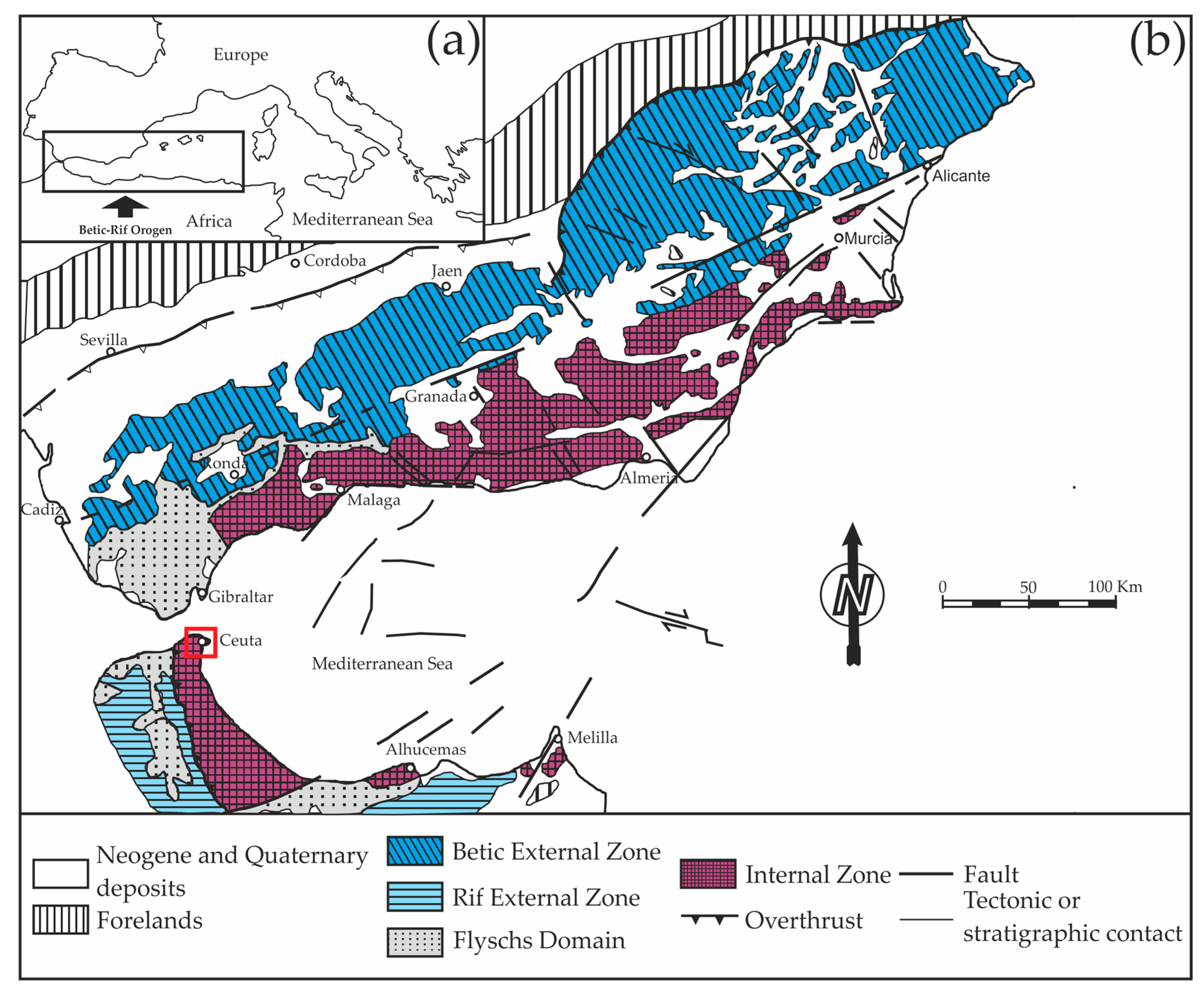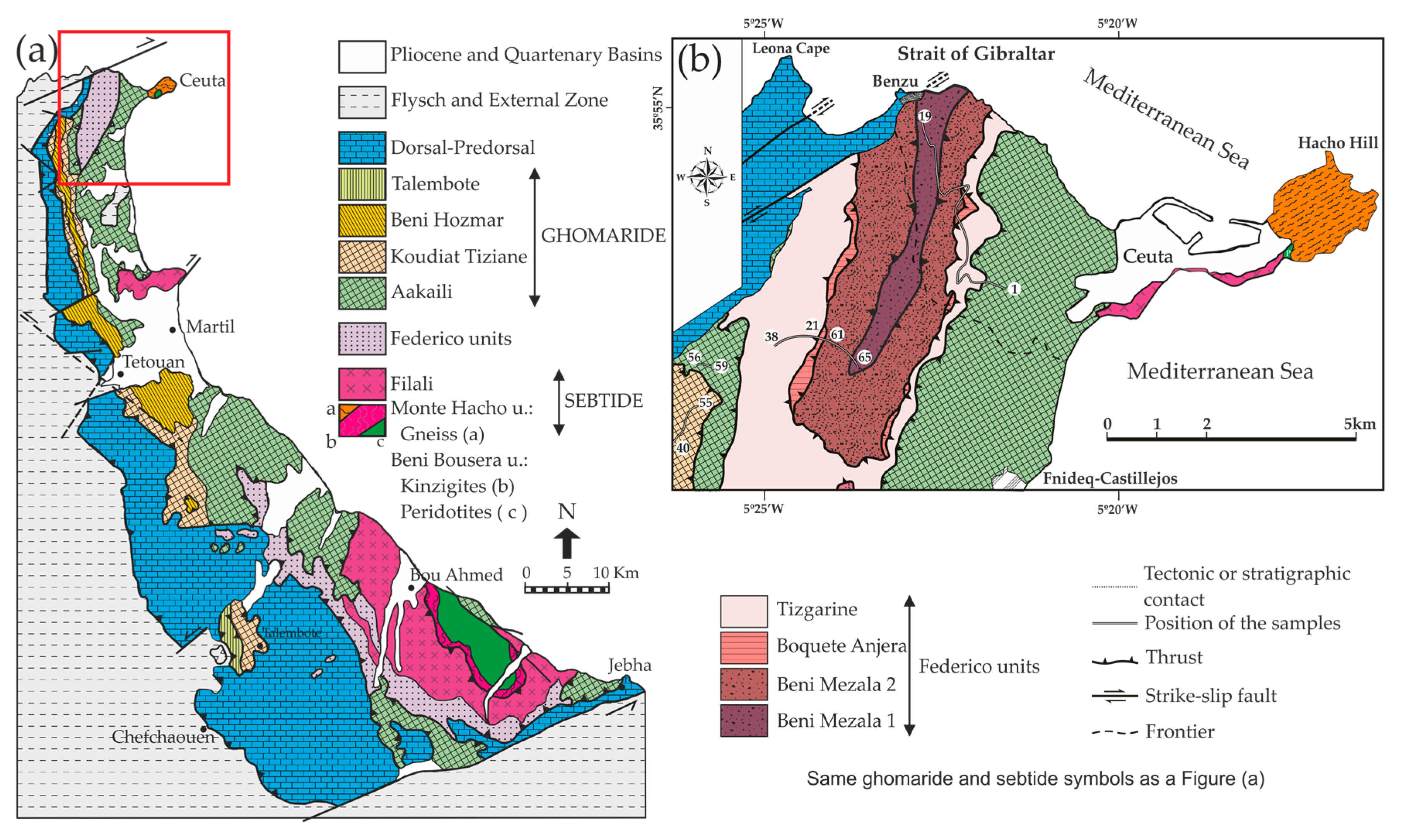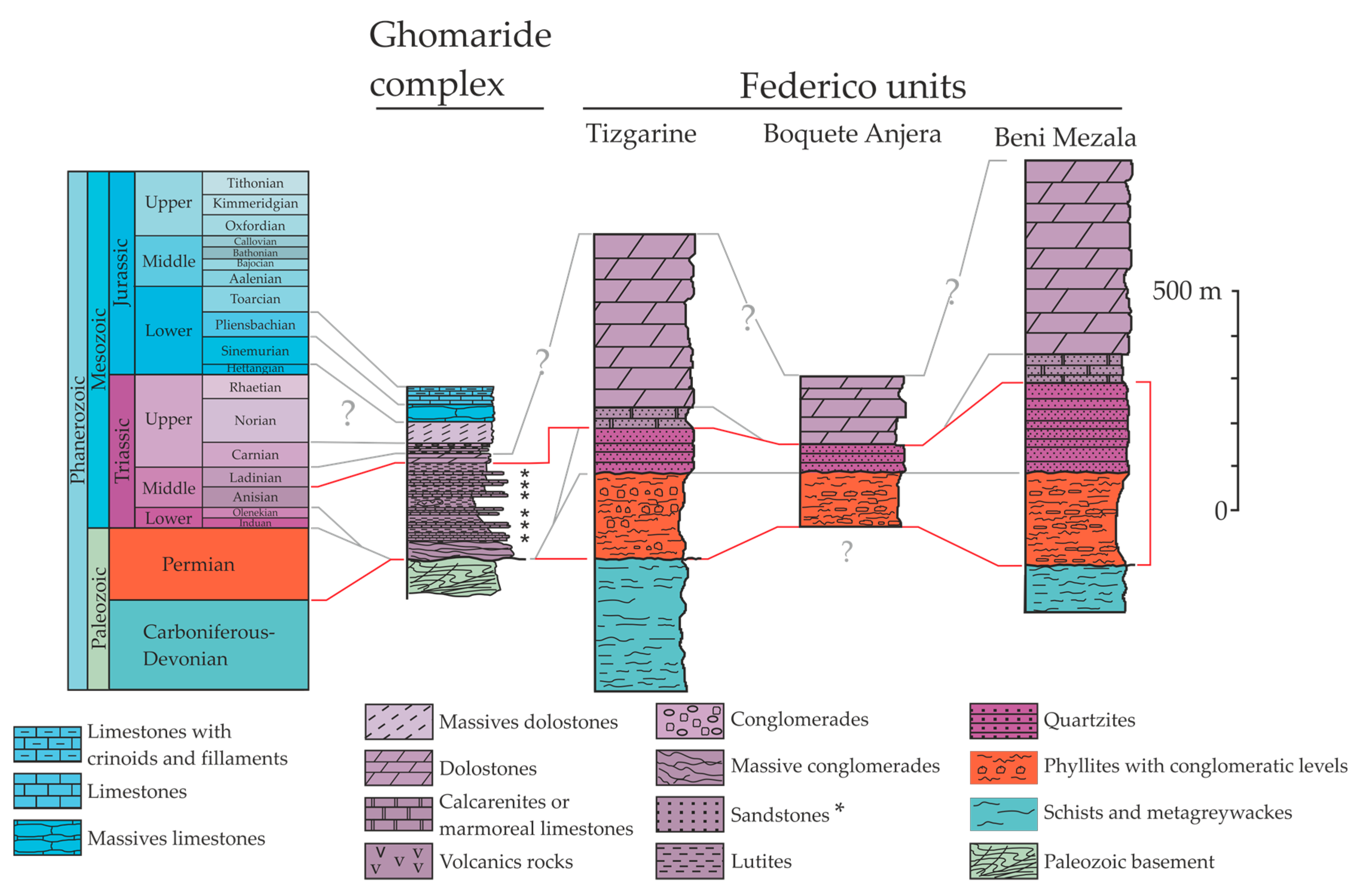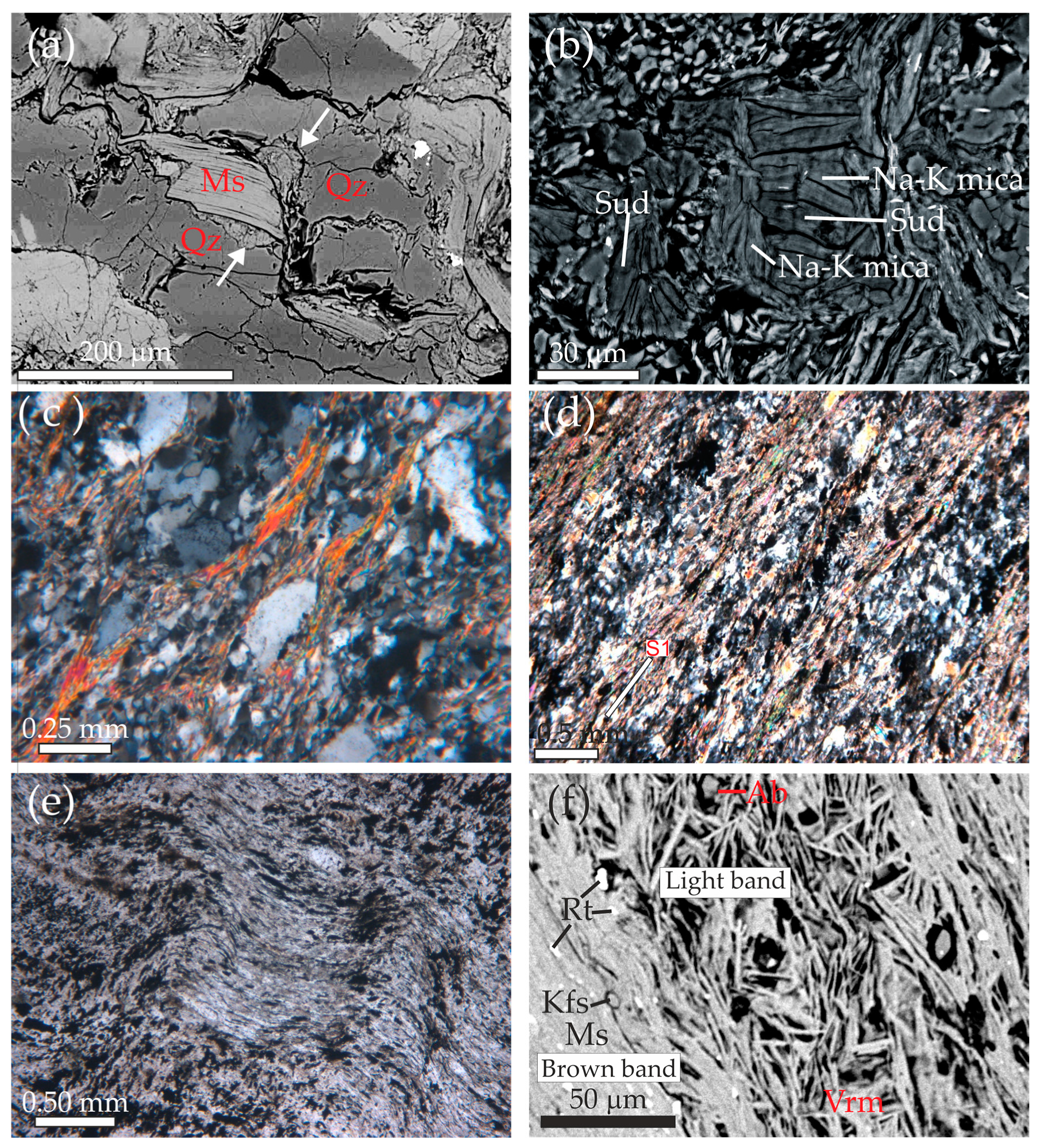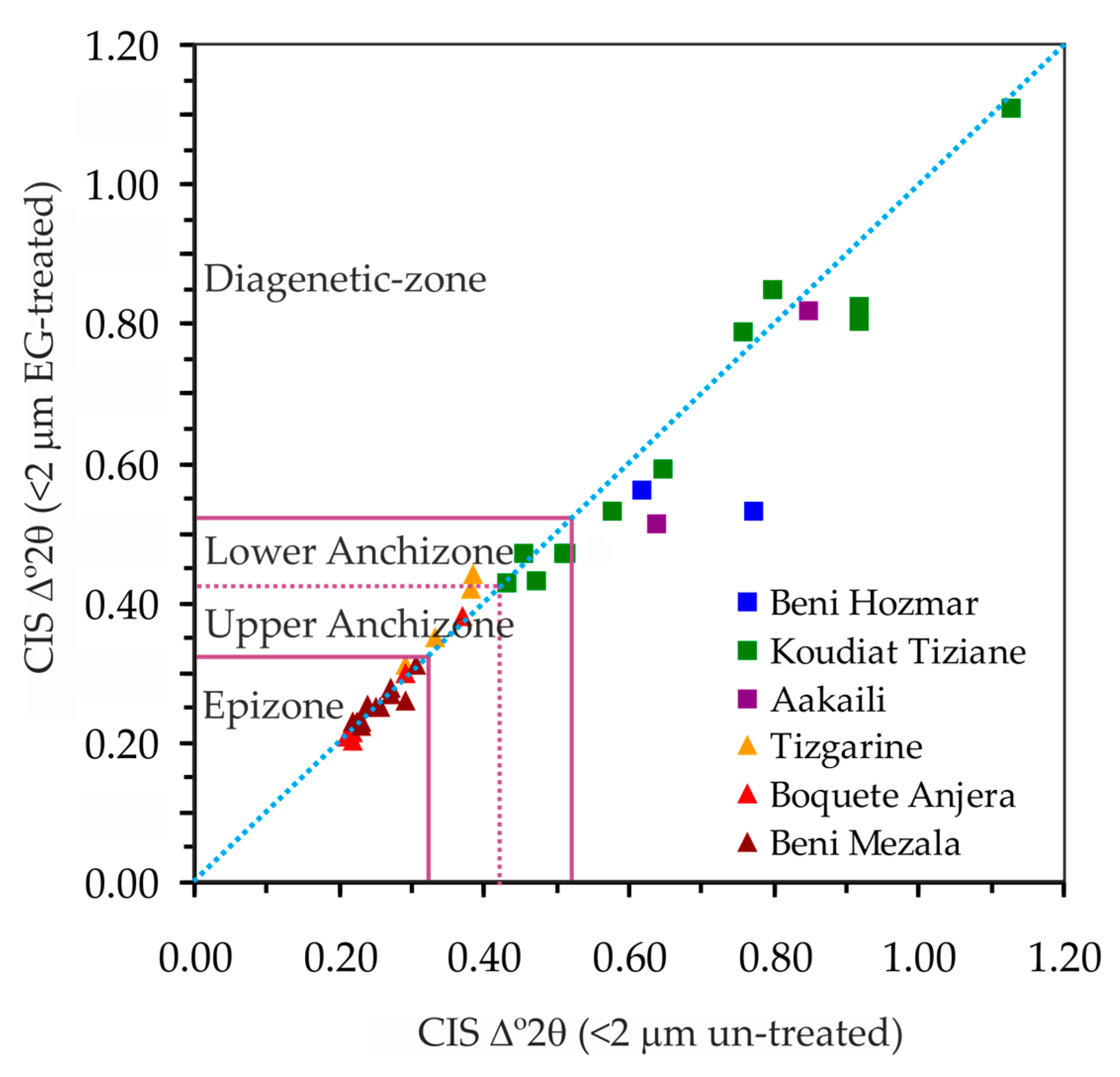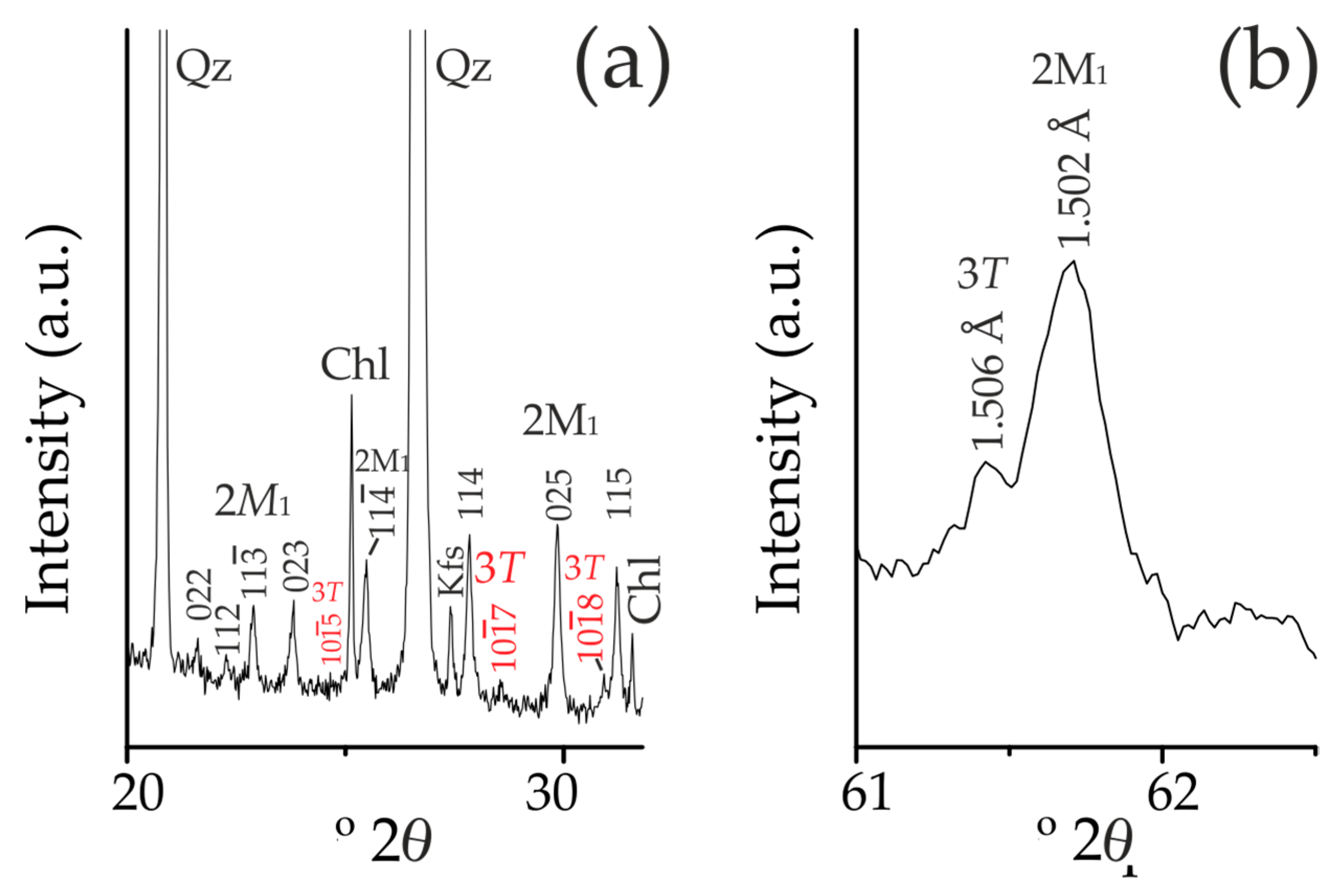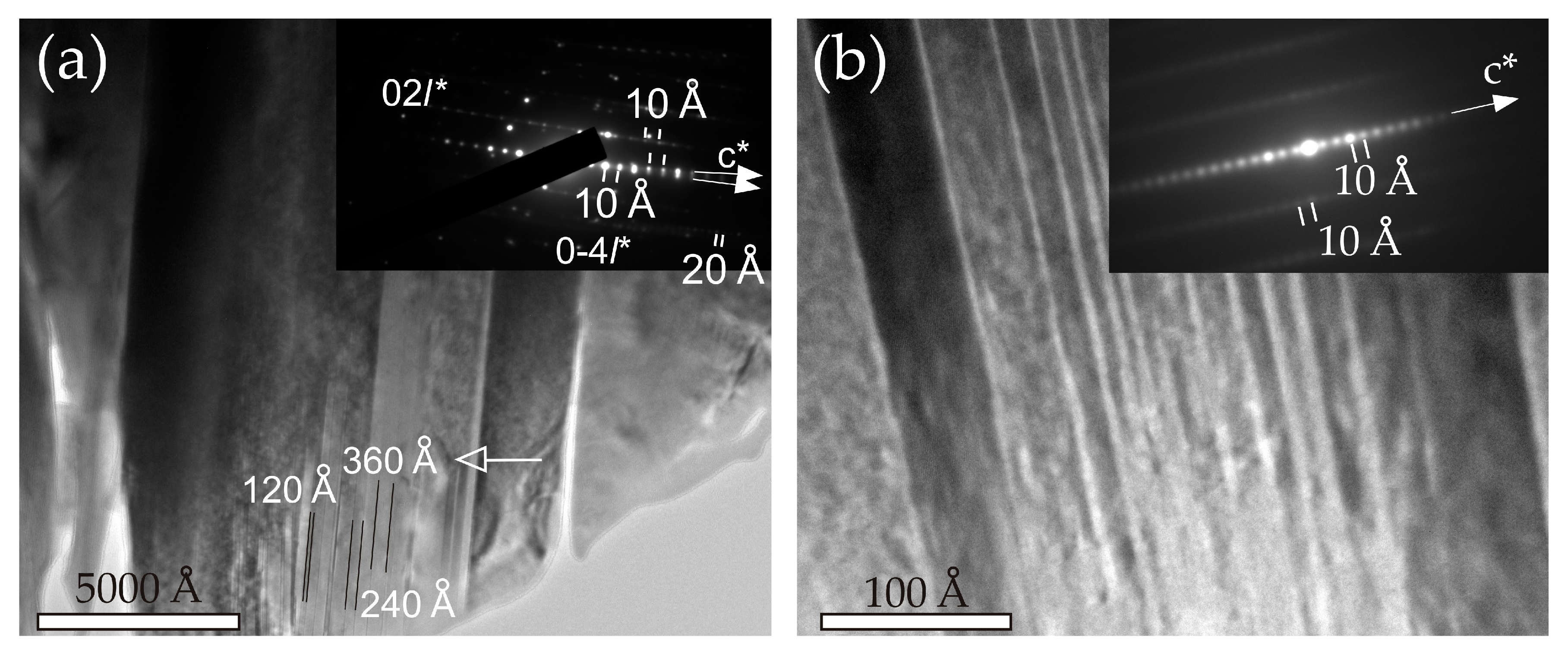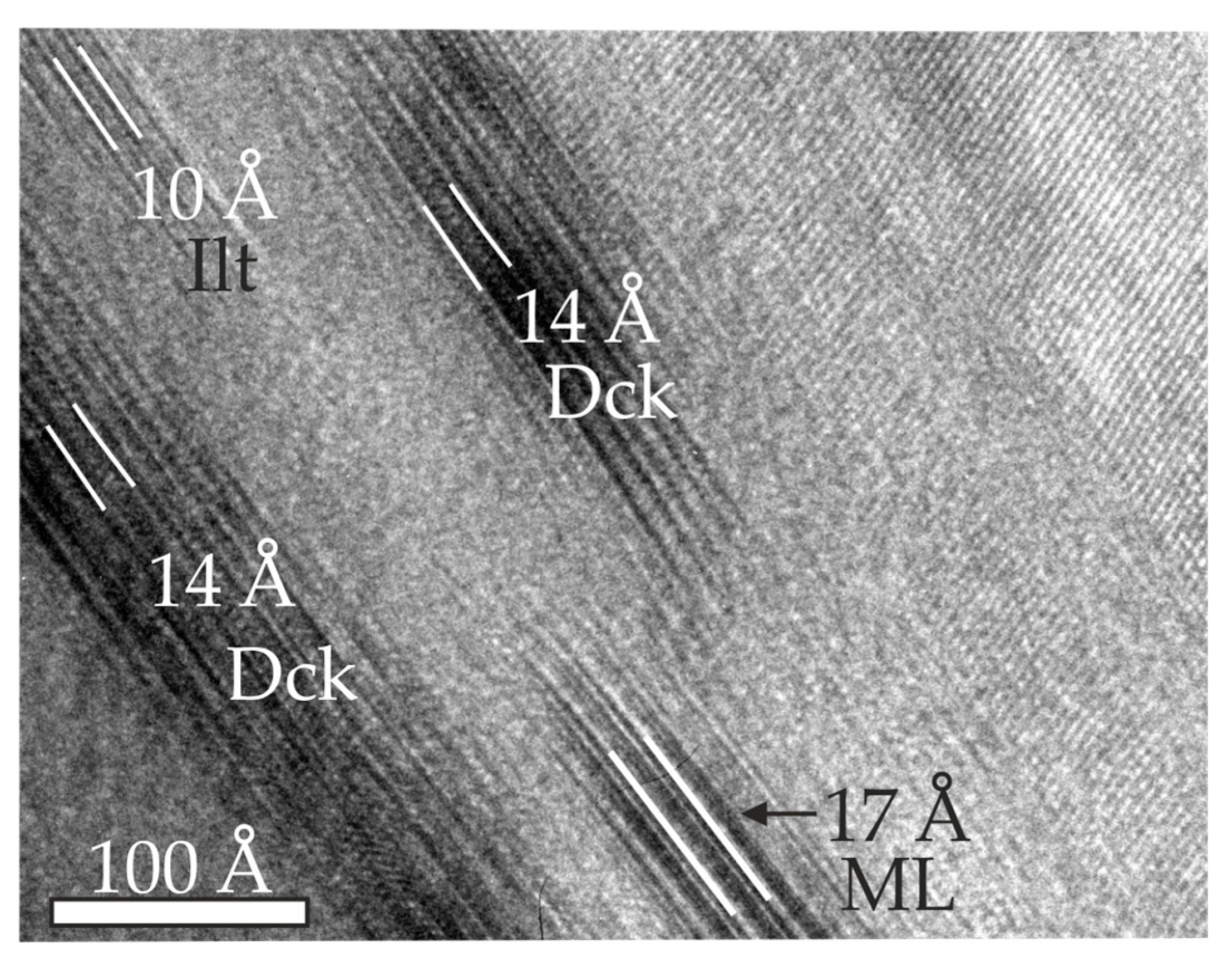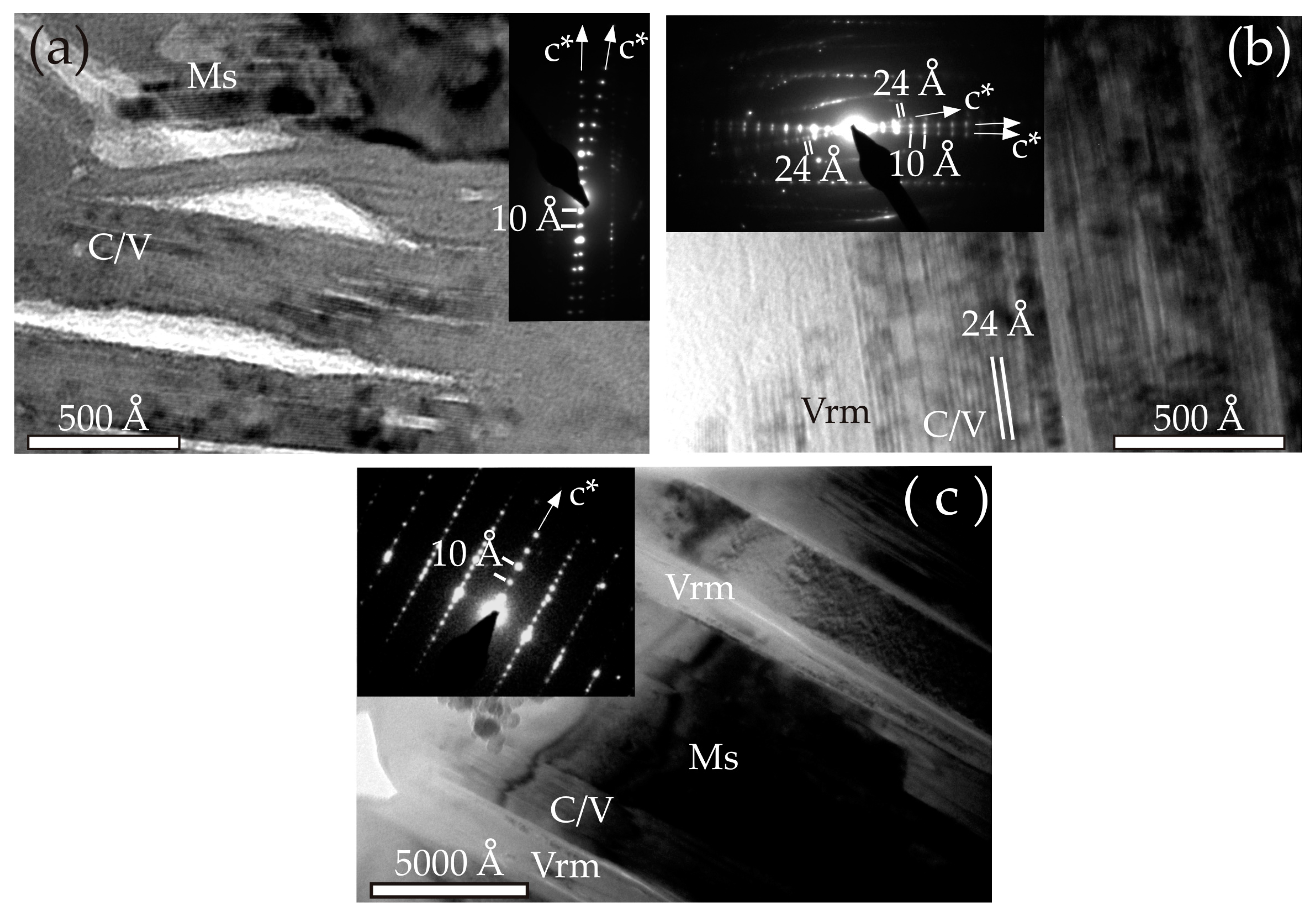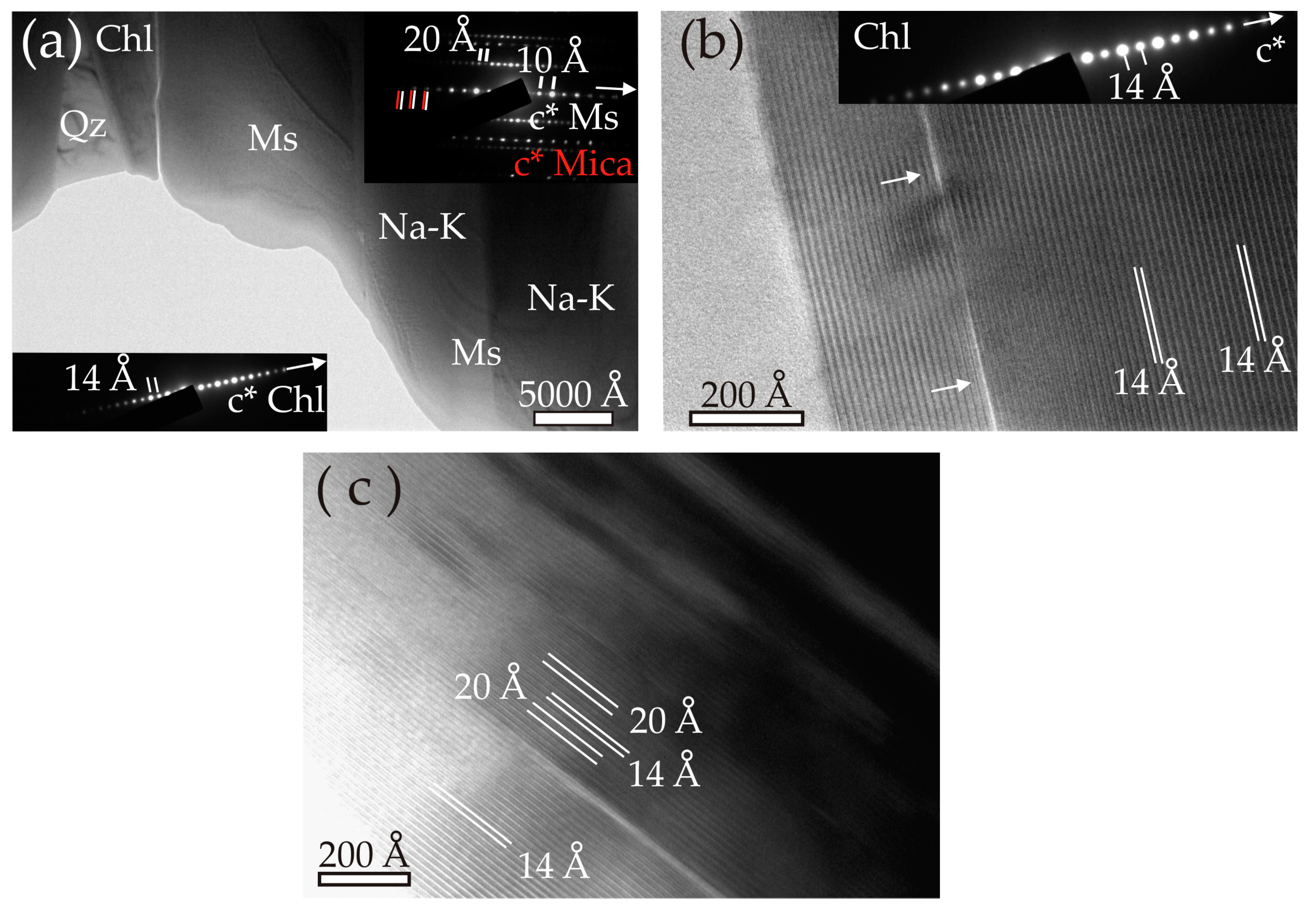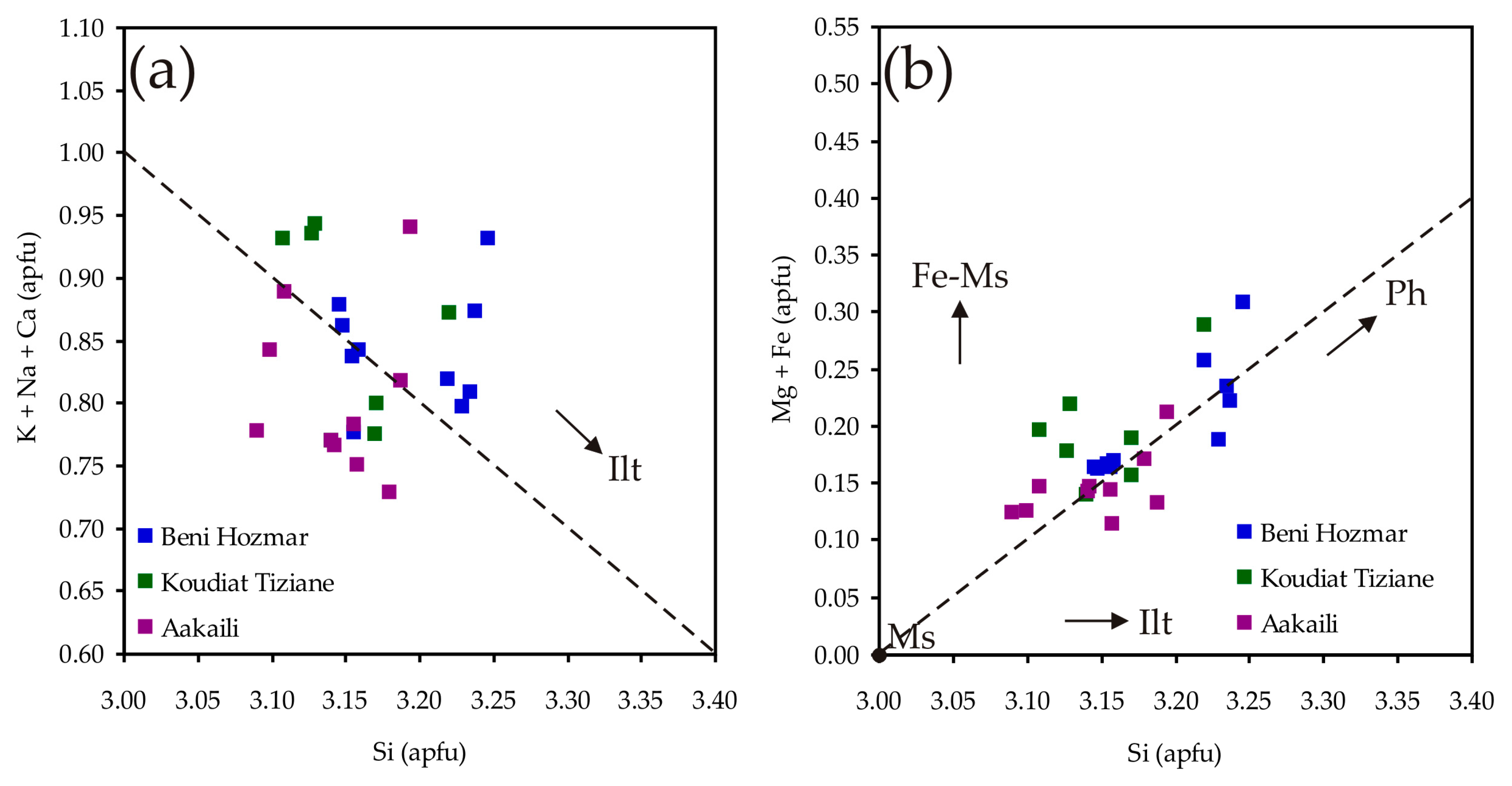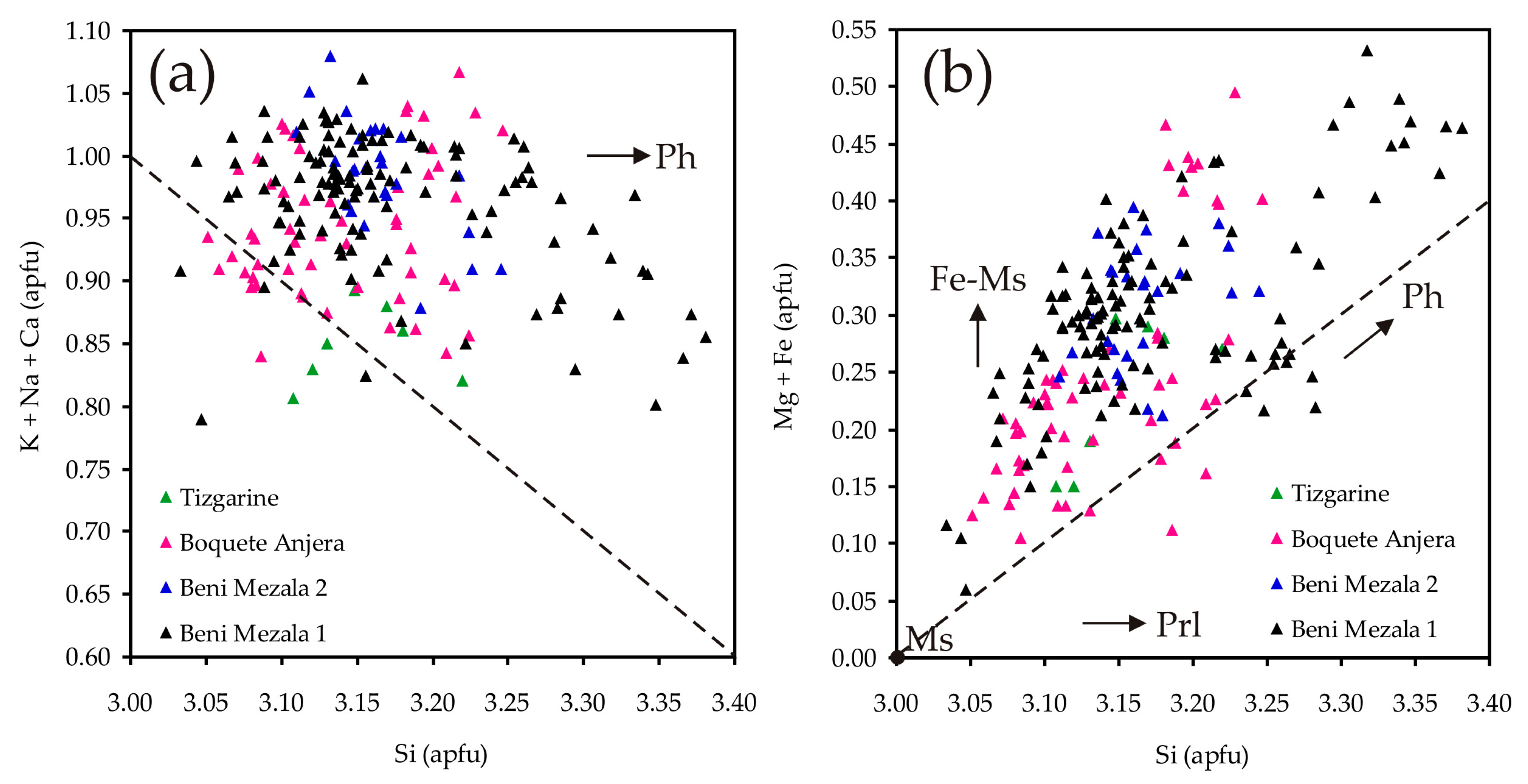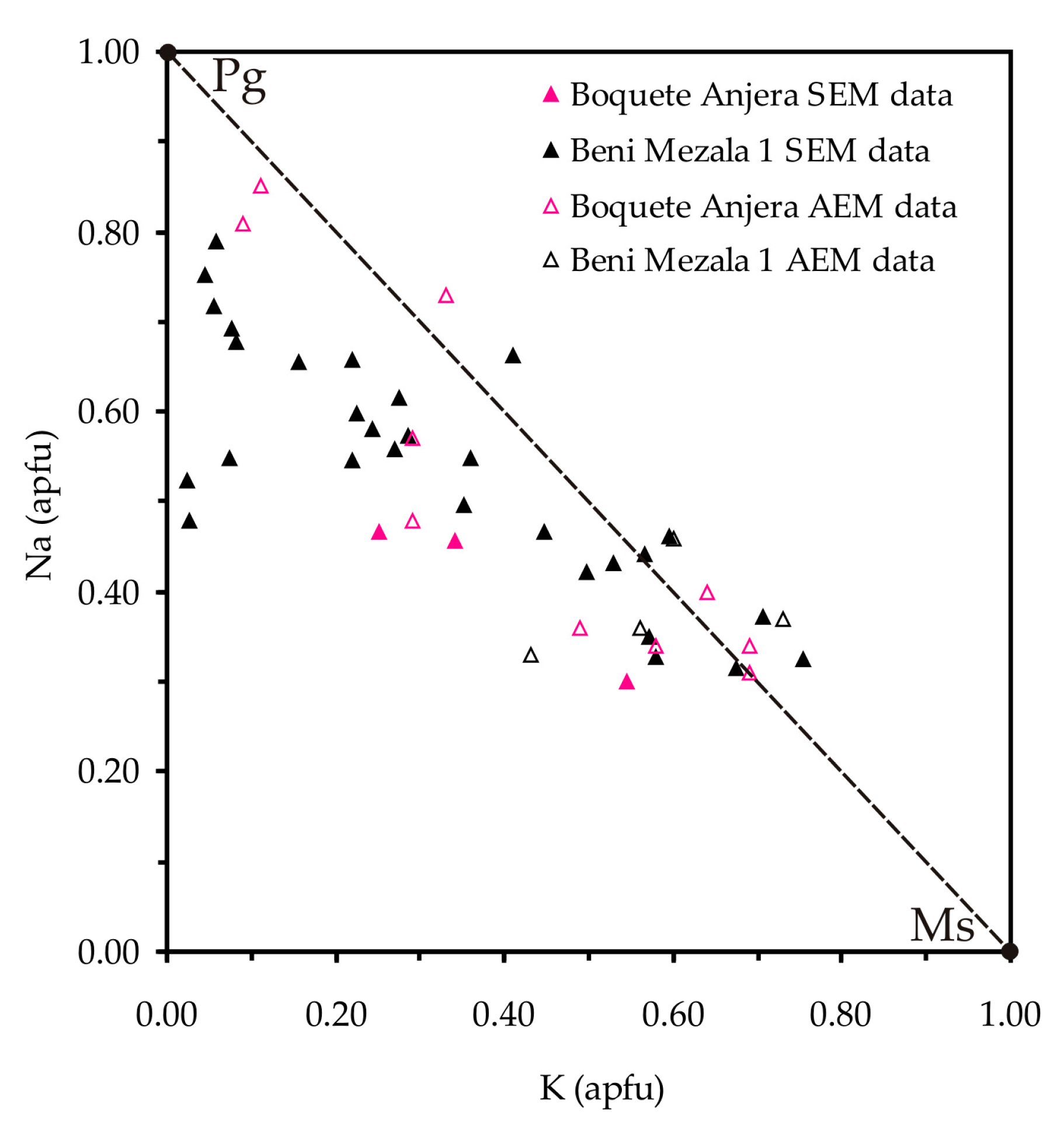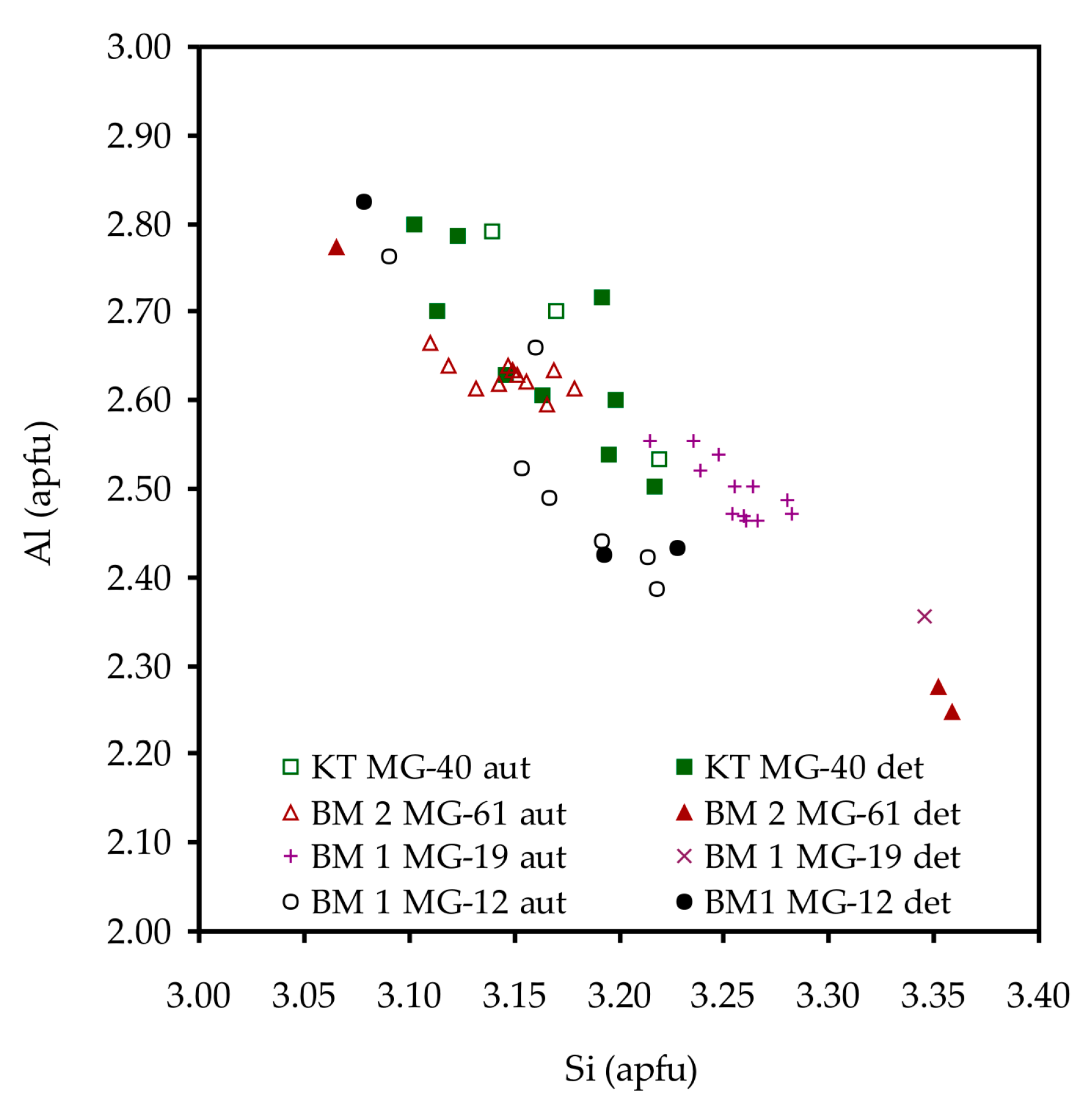1. Introduction
The establishment of metamorphic paths in very low- and low-grade metamorphic stratigraphic sequences of clastic rocks is not an easy task as textural relations among minerals are not obvious; intergrowths of phases, a general lack of equilibrium, and changes in the mineral paragenesis are characteristic below the biotite isograd [
1,
2,
3,
4,
5]. For these reasons, researchers have relied on criteria, such as polytypism, crystallite size values, or chemical characterization of the metastable sheet silicates, that are only qualitative indicators of the stages the phyllosilicates have reached through a series of metastable mineral reactions during low-temperature metamorphism [
6]. This situation emphasizes the notion of reaction progress: Metastable phyllosilicates undergoing reactions towards the state of stable chemical and textural equilibrium reached in greenschist-facies rocks [
7,
8]. According to Árkai [
9], two progressive trends of phyllosilicate crystal-chemical changes occur between early diagenesis and epizone in pelitic sequences: dioctahedral smectite–illite/smectite interstratified clay mineral–illite–dioctahedral K-rich white mica (muscovite) and trioctahedral smectite–corrensite/smectite interstratified clay mineral–chlorite/corrensite–chlorite. There is another dioctahedral series that evolves from kaolinite towards pyrophyllite, but details about this series are currently sparse in metapelitic rocks, being much more abundant in coarse-grain rocks ([
10] and references therein). In addition, the data derived from the application of different geothermometric methods, under these metamorphic conditions, may also contribute to the knowledge of the pressure (
P)–temperature (
T) paths and their tectonic significance [
11,
12].
The aim of this contribution was to characterize the low-grade metamorphism in the Ghomaride complex and Federico units from the higher units of the Internal Zone of the Rif Cordillera (N Morocco) in order to establish the
T and
P conditions reached by these metasediments and improve the interpretation of their tectonometamorphic evolution. For this purpose, a multiproxy approach was applied, including X-ray diffraction (XRD) measurements, textural and chemical characterization of mineral phases by scanning electron microscopy (SEM), and thermometric calculations. The XRD determinations include the measuring of the crystal-chemical parameters: The
b cell parameter [
13] and the illite “crystallinity” of white micas [
14]. The dataset provided here is an example of how knowledge of crystal-chemical parameters of phyllosilicate minerals contributes to the understanding of the evolution of an orogen. For the thermometric calculations, semi-empirical approaches based on the chlorite compositions [
15,
16] were used. Finally, the very fine-grained texture of these rocks, in some cases, made it necessary to examine them not only by petrographic and scanning electron microscopy but also by transmission electron microscopy (TEM). Therefore, this research aimed to establish the prograde and retrograde processes responsible for the low-grade mineral assemblages and their textural characteristics from the crystal-chemical parameters, compositions, and textural relationships up to lattice scale of phyllosilicates. In addition, there is little knowledge of the effect of more coarse-grained lithologies on the mineralogical changes during very low-grade metamorphism, and in the studied area, clastic rocks with different grain sizes were sampled, from phyllites to sandstones. Lastly, we tried to correlate all these data with the geodynamic evolution of the Rif Cordillera during the Alpine orogeny. This type of study has been previously applied to the metamorphic evolution in the equivalent Betic Cordillera units, on the other side of the Gibraltar Strait ([
17,
18,
19,
20]; among others). Meanwhile, many authors have studied the Moroccan and southernmost part of the Betic-Rif orogen in the last decades (e.g., [
21,
22,
23,
24,
25,
26,
27,
28,
29]) although mainly from a structural, geodynamic, lithostratigraphic, palaeostratigraphic, and palaeogeographic point of view.
2. Geological Setting and Materials
The Rif and Betic chains, at the south and north of the Alboran Sea, respectively, form an arc-shaped mountain belt around the Strait of Gibraltar as a consequence of the convergence between Africa and Iberia during late Mesozoic to Cenozoic. They both represent the westernmost peri-Mediterranean alpine chains (
Figure 1) and are characterized by the Internal and External Zones, Flyschs domain, and Neogene basins (
Figure 1b). The Internal Zone comprises two tectonic complexes in the Rif Cordillera: the Sebtide at the bottom and the Ghomaride at the top (so-called Alpujárride and Maláguide, respectively, in the Betic Cordillera) (
Figure 2a). The geometric relationship between them is practically constant, with the Ghomaride complex tectonically overlying the Sebtide complex except for some locations due to local and later thrusts. The differentiation of the Ghomaride and Sebtide complexes is commonly based on variations in lithology and metamorphic grade. In the Ghomaride complex, Triassic rocks include red conglomerates, sandstones, and lutites, all displaying diagenetic conditions [
30,
31,
32,
33,
34], and also carbonates at the end of the sequence. In contrast, the Permo-Triassic rocks of the underlying tectonic nappe (Sebtide) mainly include schists, phyllites with quarzitic intercalations, and marbles, reflecting incipient-to-advanced metamorphic conditions [
22,
30,
34,
35,
36]. In addition, the presence of intermediate units between these two complexes has been alternatively considered as upper Sebtide units ([
22,
30,
36,
37] and references therein) or as units intermediate between the Ghomaride and Sebtide complexes ([
33] and references therein). According to Kornprobst [
30], these units have been pointed out several places with the name of Federico units, with the denomination followed in this article.
The samples described in this work belong to the Permo-Triassic materials of the Ghomaride complex and Federico units. The sector where ghomaride and federico materials were sampled is the area between Ceuta and Fnideq (
Figure 2). Several tectonic units have been differentiated in this location, which are, from top to bottom: Beni Hozmar, Koudiat Tiziane, and Aakaili (with clear ghomaride affinity; [
30,
34,
35]) and Tizgarine, Boquete Anjera, Beni Mezala 2, and Beni Mezala 1 (Federico units, [
30]) (
Figure 2b). The three ghomaride units are formed by the same stratigraphic sequence of materials: Paleozoic phyllites, limestones, conglomerates and greywackes, Triassic conglomerates, sandstones, and lutites, with some carbonate intercalations in the middle Triassic and also carbonates at the end of the Triassic, passing to the Jurassic (
Figure 3). With respect to the Federico units, all of them show similar stratigraphic sequences: Carboniferous metagreywackes and dark phyllites at the bottom, and Permo-Triassic metapelites and conglomerates and Triassic quartzites and carbonates at the top, as can be seen in
Figure 3. According to Sanz de Galdeano et al. [
33], the stratigraphic Triassic sequences from the Federico units have intermediate characteristics (the existence or not of levels of conglomerates, the presence of pelites or metapelites and specially the development of carbonates) in relation to the Triassic successions of the sebtide and ghomaride units. The transition from the upper unit (Tizgarine) to the lower units is marked by a change in color from red to blue and an increase in metamorphic grade, which was recognized earlier by Milliard [
39].
A total of 46 samples of Permo-Triassic clastic rocks were taken, 17 from the Ghomaride complex and 29 from the Federico units (
Table 1 and
Table 2). During the sampling, the outer surficial material was removed to avoid any contamination by surface weathering.
5. Discussion
The study of the mineral assemblages, crystal-chemical parameters of K-white micas, and chemical characterization of phyllosilicates of the clastic rocks of the Ghomaride complex and Federico units is of relevance to the understanding of the diagenetic-metamorphic evolution of these materials after their deposition during the Permo-Triassic.
The rocks of the studied sector include a large range of diagenesis in the Ghomaride complex, with the illite “crystallinity” defining a trend from a very low-temperature environment to epizonal metamorphism in the deepest Federico units (
Figure 5). Nevertheless, the evolution of the illite “crystallinity” is not strictly progressive; rather, it shows an abrupt change at the boundary between the Ghomaride complex and Federico units and another step within the Boquete Anjera unit, close to the boundary with the Tizgarine one, probably due to mechanical contacts between Ghomaride complex and Federico units and between Tizgarine and Boquete Anjera tectonic units (
Figure 17). The first one marks the transition from the diagenetic to the anchizone and the second one the transition from the anchizone to the epizonal conditions. In any case, there is undoubtedly a clear increase of illite “crystallinity” with depth and this is in coherence with the mineralogical and textural evolution, as it will be addressed in the following paragraphs.
Specifically, the crystal-chemical parameters and mineral assemblages of the ghomaride sandstones established by XRD are similar to the few pelites found in the Ghomaride complex. Obviously, the pelites have a higher proportion of phyllosilicates. However, according to previous works [
58,
59], although sandstones and pelites can be very different in relation to macroscopic features and mechanical aspects, it is not like that at the nanoscale nor in the chemistry of phyllosilicates. Illite, kaolinite, and minor quantities of illite/smectite mixed-layers and chlorite are present in the shallowest samples. Other phyllosilicates as dickite and sudoite were also identified in deeper samples with CIS values close to the diagenesis–anchizone boundary, forming, in some cases, intergrowths with illite or a wide variety of mixed-layer structures at the nanoscale. A detailed study about the mechanisms of the formation of kaolinite, dickite, sudoite, and illite in these units have been carried out by Ruiz Cruz et al. [
3], where a temperature of ~150 °C is given for the kaolinite-dickite reaction in coherence with the CIS data presented here. Moreover, these clay minerals have also been described in the equivalent units of the Betic Cordillera [
3,
17,
60]. Lastly, in the deepest ones (Aakaili Unit), Na-K mica appears for the first time. The mineral assemblages of the Federico units’ samples are characterized by the appearance of an index mineral, pyrophyllite in Tizgarine unit, coinciding with the lower anchizone limit (
T ~200 °C) and coexisting with minor dickite, illite-muscovite (K and Na-K), and chlorite (tri- and di-tri). The appearance of pyrophyllite was explained as a transformation of dickite observed in selected Triassic samples from the Betic-Rif Cordillera ([
3],
Figure 5). Clastic rocks from Boquete Anjera show several differences from the previous ones: the first appearance of paragonite, the presence of true muscovites, and, from the textural point of view, a well-developed slaty cleavage. All these observations coincide with epizone values. These features are also present in the samples corresponding to the deepest unit (Beni Mezala), where Na-Ca mica, talc, vermiculite, chlorite/vermiculite, and kaolinite have been well described sporadically, although the last two mineral phases are not the result of a prograde evolution, as it will be commented later.
The mineral evolution described through the Beni Mezala antiform is a very good example of reaction progress in the frame of the Ostwald-step processes [
7]: Metastable clay systems undergoing reactions towards chemical and textural equilibrium, which is almost reached in the epizone samples. The coexistence of illite/smectite mixed-layers and illite small packets in the diagenetic samples, which are substituted by large crystals of muscovite and paragonite in the highest metamorphic grade samples, or the presence of pyrophyllite in Tizgarine unit (lower anchizone), but the absence of kaolinite, fit quite well with the trends previously described by other authors ([
8,
9,
10]; among others). In this sense, samples in which muscovite, paragonite, and intermediate Na-K mica occur together (
Table 2 and
Figure 14) are consistent with metastability, not only because more than two such micas appear but also because their compositions are incompatible with the solvus in the muscovite-paragonite system [
61,
62]. The existence of true intermediate Na-K mica was already demonstrated by TEM/AEM studies [
61,
63], although later, Livi et al. [
64] proposed the nano-domain model, which supposes that clay minerals may contain a wide range of cations mixed non-homogeneously within an interlayer at low temperatures. Finally, in relation to the mica polytypism, the most common polytype in the studied samples is the 2
M1, which is typical of metamorphic micas, but the 1
M polytype occurs also in some diagenetic samples (Ghomaride complex) and the 3
T polytype in some epizone samples. The appearance of different mica polytypes is also indicative of a lack of equilibrium. The occurrence of minerals that correspond to different conditions and consequently, different times on the PTt (Pressure-Temperature-time) path, giving non-equilibrium mineral assemblages, is a common feature in low-grade metamorphic rocks.
The
b cell parameter of dioctahedral micas, ranging from 8.987 to 9.036 Å and roughly increasing from the ghomaride samples to the Federico ones, is also characteristic of low (1–2 kbar) to intermediate (2–3 kbar) pressure regional metamorphism according to Guidotti and Sassi [
13]. However, in the deepest Federico units (Boquete Anjera and Beni Mezala units), the presence of 3
T mica polytype (
Figure 6) and the wide range of phengitic substitution values (Si from 3 up to more than 3.35
apfu,
Figure 13b) indicates the coexistence of mica grains formed under a wider range of pressure. The detailed research carried out by Ruiz-Cruz et al. [
65] about the petrology of the phyllites and the enclosed veins found in the Beni Mezala 1 sequence showed the presence of pumpellyite—actinolite—epidote in the veins from Permo-Triassic formations, indicating pressures of ~2 kbar. This agrees with the estimations deduced from crystal-chemical parameters of white mica (CIS,
b) from the enclosing pumpellyite-free phyllites (MG-14 and MG-13,
Table 2). Nevertheless, the outstanding presence of kyanite-bearing veins in the same area suggests pressure conditions of 5 kbar [
65]. With respect to the temperature conditions, in addition to the CIS values and the presence of minerals as pyrophyllite (
T ~200 °C, lower anchizonal limit) and paragonite (anchizone and epizone mineral), semi-empirical chlorite thermometers show results for the deepest Federico units that are coherent with the rest of the data. Temperature ranges are narrower in samples from the Boquete Anjera unit (250–400 °C) than in Beni Mezala 1 unit (150–350 °C), but in any case, these temperature ranges suggest the genesis of several populations of chlorites during the PTt evolution of the orogen as in the case of dioctahedral micas as it is commented below. In relation to the thermal conditions, the enclosed veins found in the Beni Mezala 1 sequence indicate temperatures of ~250 °C and the kyanite-bearing veins in the same area suggest peak conditions of 400 °C [
65]. Nevertheless, these estimates in Beni Mezala 1 unit are far from those deduced by Bouybaouène [
22] and Bouybaouène et al. [
24] based on paragenesis with carpholite and talc, and other data relative to the Betic Cordillera [
66].
According to our data, the presence of micas 3
T is interpreted as being formed during the Alpine episode of high pressure and low temperature (H
P/L
T), which implies a collisional regime ([
22,
24,
66,
67]; and see [
68,
69,
70] for a review). Nevertheless, the 2M
1 micas have to be the result of a rebalancing of part of the first population of micas 3
T during the highest temperature and lowest pressure episode that characterized the beginning of the exhumation of the orogen. A similar interpretation was made by Frey et al. [
52] and Stökhert [
53] for explaining the coexistence of these two polytypes of mica in polymetamorphic rocks of the Alps. In this research, the continuous trend observed in mica compositions also corroborates this hypothesis, reflecting the decompression path after the peak pressure. The maximum phengitic values give the pressure of the H
P episode and the average is coherent with the
b parameter. A similar reasoning was developed by Abad et al. [
71] for the Tien Shan Cordillera. Coherently, the Ghomaride samples show a lower range of phengitic compositions (
Figure 12b) and a lower
b parameter. The large range of diagenesis in the Ghomaride complex, with the CIS data defining a trend from a very low-temperature environment to epizonal metamorphism in the deepest Federico units, just overlying the Sebtide complex, fits with the PTt path established by Azañón and Crespo-Blanc [
72] for the Central Betics, resulting in other cases of diagenetic to low-grade metamorphic sequence subject to tectonic stress, which favored the prograde reaction series, instead of burial depth ([
17,
73], among others).
In relation to the presence of low-
T mineral phases as chlorite/vermiculite and kaolinite (MG-18,
Table 2) in the deepest Federico units, the study of strongly deformed sudoite-bearing synfolial quartz veins present in this whitish schist [
74] suggests a retrograde event altering the sudoite to chlorite/vermiculite intergrowth, kaolinite, and minor Fe oxide, probably during the latest stage of exhumation, under low-temperature conditions. This retrograde diagenetic [
75] process has been described in both the intermediate units [
17,
19] and other complexes of the Betic Cordillera [
76,
77].
Lastly, considering the different positions in the geological literature on the existence or not of intermediate units between the Ghomaride and Sebtide complexes over time ([
22,
25,
30,
33,
37] and references therein), the mineral data presented here suggest that the transition between Ghomaride and Sebtide complexes is gradual as concluded by Sanz de Galdeano et al. [
33]. So, we suggest that the Federico units can be considered intermediate units, and in the case that they were considered the cover of Sebtide complex, it is evident that Tizgarine unit shows more affinity for the ghomaride units than for the deepest Federico ones, as evidenced by the lithological characteristics, the progressive trends of phyllosilicates assemblages, and chemical compositions of the K-white micas.
6. Conclusions
The Beni Mezala antiform is characterized by a complete sequence of clastic rocks ranging from diagenetic (Ghomaride complex) to epizone conditions (Boquete Anjera and Beni Mezala, Federico units) favored by the tectonic stress of the Alpine orogeny. The reaction progress is evidenced through the clay minerals’ evolution (mineral phases, CIS values, polytypes, and textural and chemical features).
The identification of different polytypes in micas (1M, 2M1 in ghomaride samples and 2M1, 3T in Federico samples) together with the continuous trend observed in the mica composition, with a wide range of phengitic values, suggests a PTt evolution of the orogen after the peak pressure, which is coherent with the average value given by the b parameter (3–1 kbar), reflecting a decompression path. The 2M1 micas would be the result of the rebalancing of part of the high P population of micas 3T (characteristic of the collisional setting) during a subsequent low pressure and high temperature episode, which characterized the beginning of the exhumation of the orogen. The temperature estimates based on index minerals, CIS data, and chlorite geothermometry give ranges from 150 to 400 °C, the highest temperatures in the deepest samples of the Federico units. The chlorite geothermometry also allowed confirmation of the genesis of several populations of chlorite.
Finally, and regarding the results shown in this article, Federico units can be considered intermediate units between the diagenetic Ghomaride complex and the green-schist facies that characterized the Sebtide complex, although under the mineral data presented here Tizgarine unit shows more affinity for the Ghomaride complex than for the deepest Federico units.
